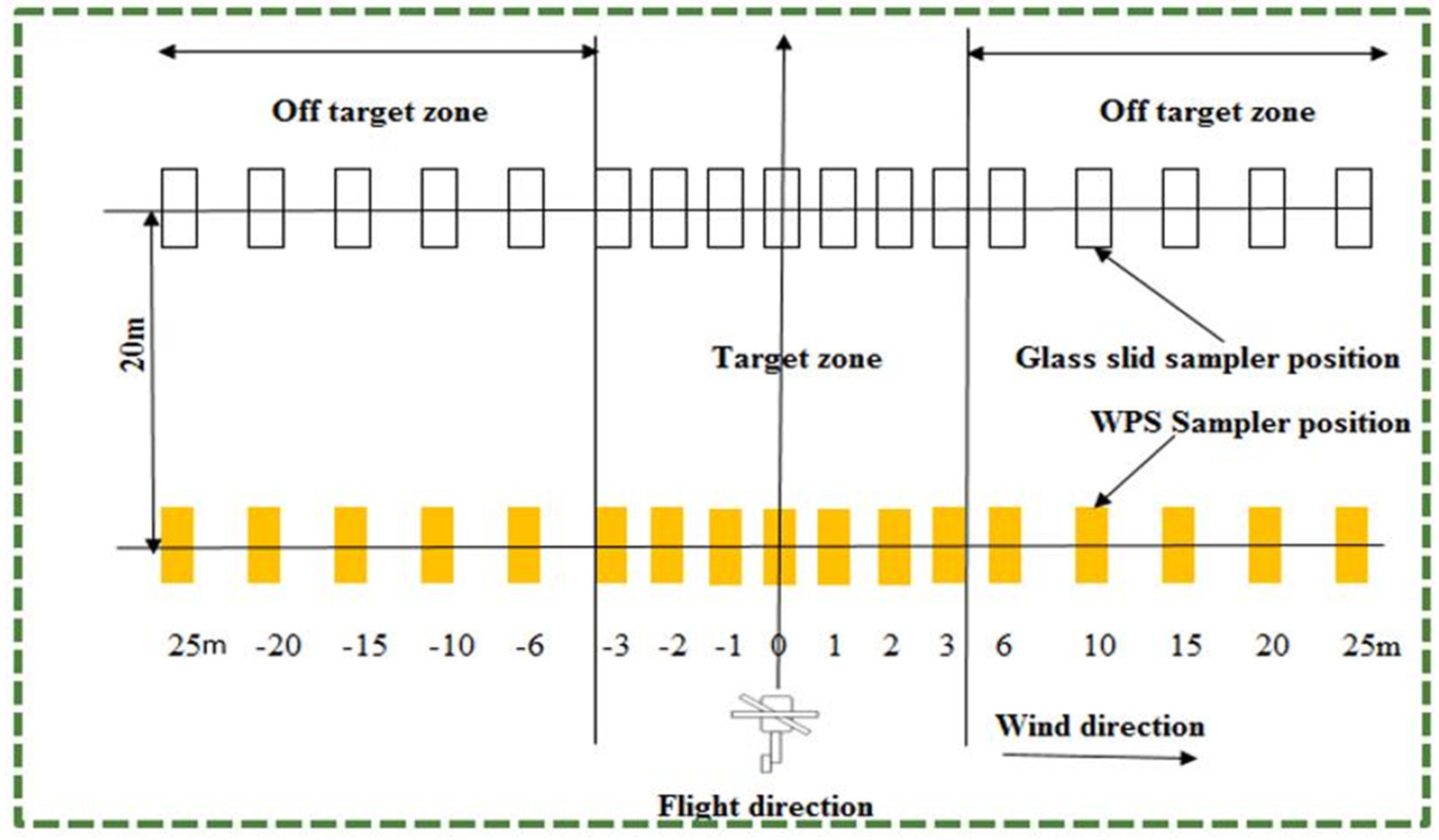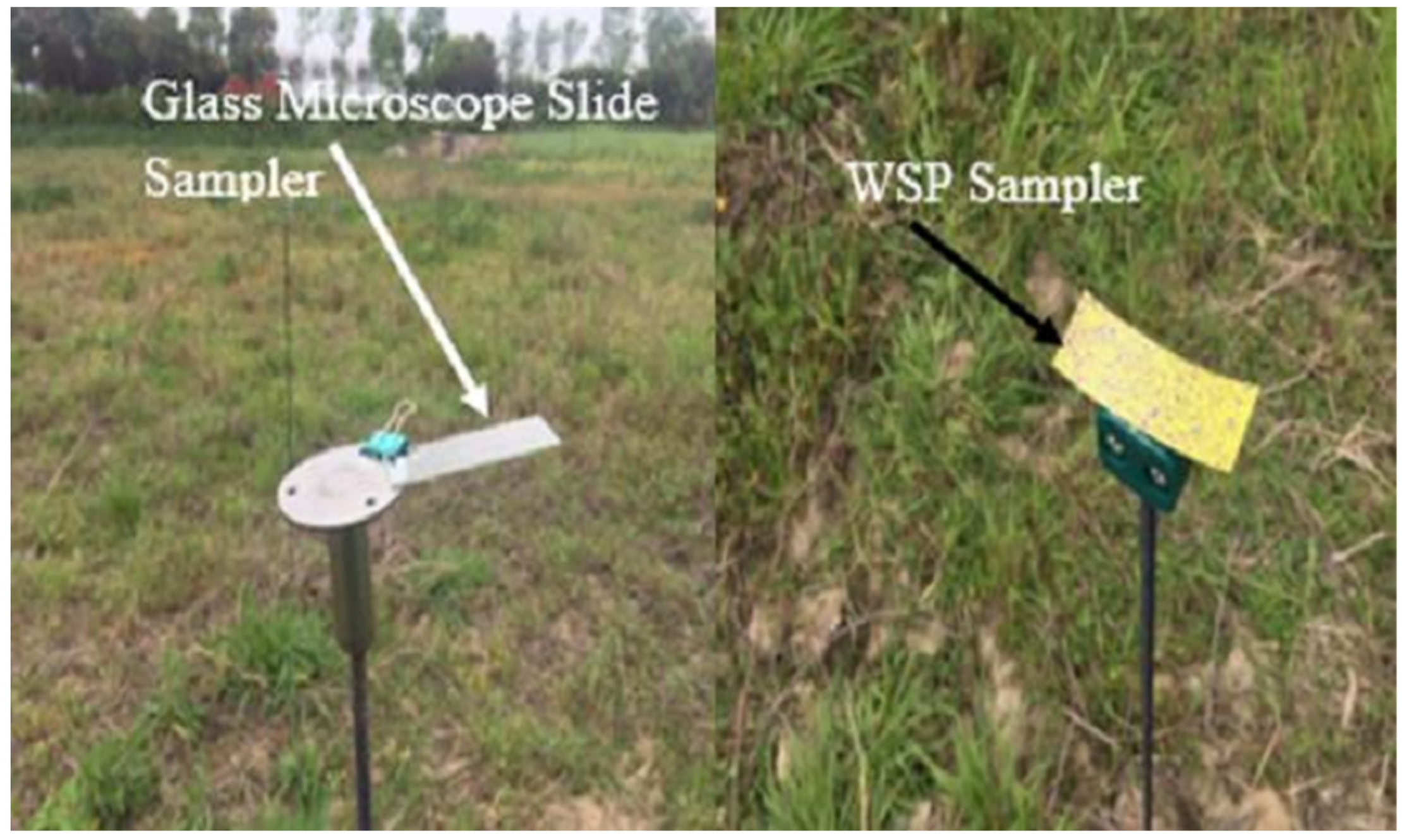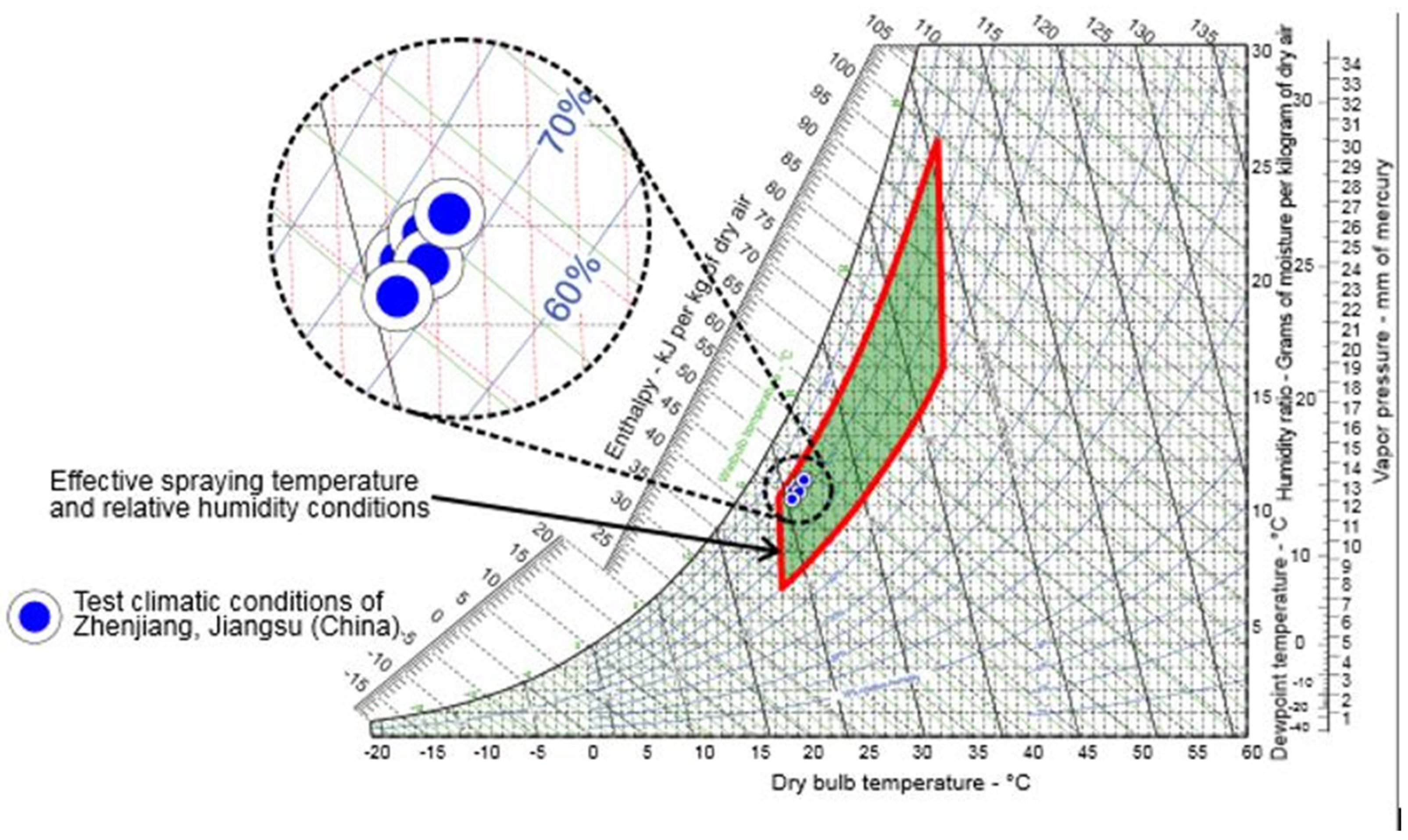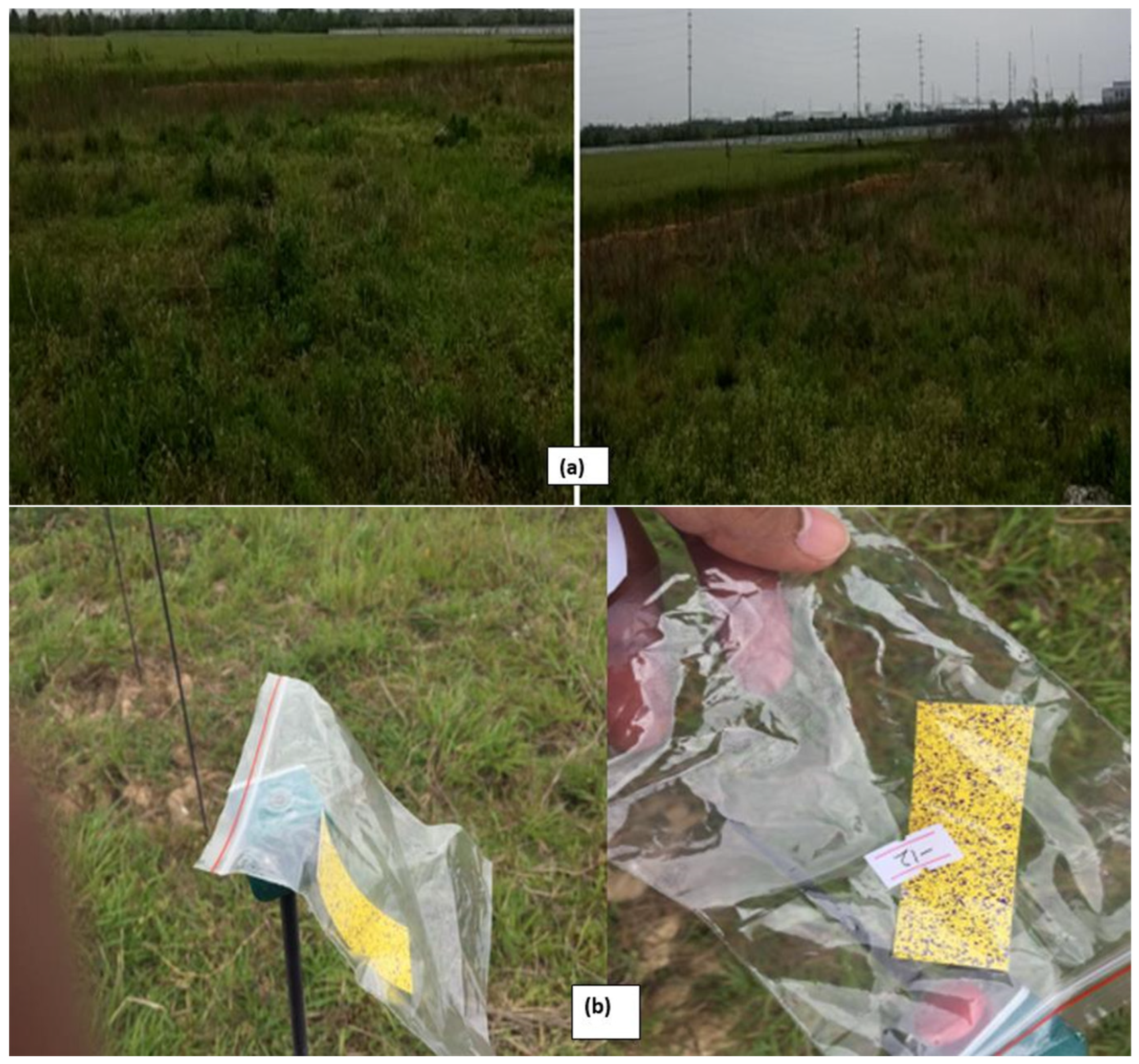Comparison of Water Sensitive Paper and Glass Strip Sampling Approaches to Access Spray Deposit by UAV Sprayers
Abstract
:1. Introduction
2. Materials and Methods
2.1. Description of the Test Site
2.2. UAV Sprayer Parameters and Spraying Device
2.3. Experimental Design
2.4. Sampling Setup for Field Evaluation
2.5. Spray Data Acquisition and Processing
2.6. Statistical Analysis
3. Results and Discussion
3.1. Effect of the Operative Parameters on Spraying Deposition Determined by Samplers
3.2. Effect of Sampler Type on the Droplet Deposition Measurement
4. Conclusions
Author Contributions
Funding
Institutional Review Board Statement
Informed Consent Statement
Data Availability Statement
Acknowledgments
Conflicts of Interest
References
- Chao, X.G.; ChenN, S.; Qiu, W.; Lv, X.L.; Li, H.; Han, C.J.; Ahmad, F. Simulation and validation of the air flow generated by a multi-channel air-assisted sprayer. IEEE Access 2019, 7, 94848–94857. [Google Scholar] [CrossRef]
- Hussain, S.; Cheema, M.J.M.; Arshad, M.; Ahmad, A.; Latifm, M.A.; Ashraf, S.; Ahmad, S. Spraying Uniformity Test ing of Unmanned Aerial Spraying System for Precision Agro-chemical Applications. Pak. J. Agric. Sci. 2019, 56, 897–903. [Google Scholar] [CrossRef]
- Lan, Y.; Chen, S. Current status and trends of plant protection UAV and its spraying technology in China. Int. J. Precis. Agric. Aviat. 2018, 1, 1–9. [Google Scholar] [CrossRef]
- Liao, J.; Zang, Y.; Luo, X.; Zhou, Z.; Lan, Y.; Zang, Y.; Gu, X.; Xu, W.; John Hewitt, A. Optimization of variables for maximizing efficacy and efficiency in aerial spray application to cotton using unmanned aerial systems. Int. J. Agric. Biol. Eng. 2019, 12, 10–17. [Google Scholar] [CrossRef]
- Lv, M.; Xiao, S.; Yu, T.; He, Y. Influence of UAV flight speed on droplet deposition characteristics with the application of infrared thermal imaging. Int. J. Agric. Biol. Eng. 2019, 12, 10–17. [Google Scholar] [CrossRef] [Green Version]
- Abd Kharim, M.N.; Wayayok, A.; Mohamed Shariff, A.R.; Abdullah, A.F.; Husin, E.M. Droplet deposition density of organic liquid fertilizer at low altitude UAV aerial spraying in rice cultivation. Comput. Electron. Agric. 2019, 167, 105045. [Google Scholar] [CrossRef]
- Zhang, P.; Deng, L.; Lyu, Q.; He, S.L.; Yi, S.L.; Liu, Y.D.; Yu, Y.G.; Pan, H.Y. Effects of citrus tree shape and spraying height of small unmanned aerial vehicle on droplet distribution. Int. J. Agric. Biol. Eng. 2016, 9, 45–52. [Google Scholar] [CrossRef]
- Wang, S.; Li, X.; Zeng, A.; Song, J.; Xu, T.; Lv, X.; He, X. Effects of Adjuvants on Spraying Characteristics and Control Efficacy in Unmanned Aerial Application. Agriculture 2022, 12, 138. [Google Scholar] [CrossRef]
- Ahmed, S.; Xin, H.; Faheem, M.; Qiu, B. Stability Analysis of a Sprayer UAV with a Liquid Tank with Different Outer Shapes and Inner Structures. Agriculture 2022, 12, 379. [Google Scholar] [CrossRef]
- Ahmed, S.; Qiu, B.; Ahmad, F.; Kong, C.-W.; Xin, H. A State-of-the-Art Analysis of Obstacle Avoidance Methods from the Perspective of an Agricultural Sprayer UAV’s Operation Scenario. Agronomy 2021, 11, 1069. [Google Scholar] [CrossRef]
- Qin, W.-C.; Qiu, B.-J.; Xue, X.-Y.; Chen, C.; Xu, Z.-F.; Zhou, Q.-Q. Droplet deposition and control effect of insecticides sprayed with an unmanned aerial vehicle against plant hoppers. Crop Prot. 2016, 85, 79–88. [Google Scholar] [CrossRef]
- Ahmad, F.; Qiu, B.; Dong, X.; Ma, J.; Huang, X.; Ahmed, S.; Ali Chandio, F. Effect of operational parameters of UAV sprayer on spray deposition pattern in target and off-target zones during outer field weed control application. Comput. Electron. Agric. 2020, 172, 105350. [Google Scholar] [CrossRef]
- Teske, M.E.; Wachspress, D.A.; Thistle, H.W. Prediction of Aerial Spray Release from UAVs. Trans. Asabe 2018, 61, 909–918. [Google Scholar] [CrossRef] [Green Version]
- Sunada, S.; Tanaka, K.; Kawashima, K. Maximization of thrust-torque ratio of a coaxial rotor. J. Aircr. 2005, 42, 570–572. [Google Scholar] [CrossRef]
- Martin, D.; Singh, V.; Latheef, M.A.; Bagavathiannan, M. Spray Deposition on Weeds (Palmer Amaranth and Morningglory) from a Remotely Piloted Aerial Application System and Backpack Sprayer. Drones 2020, 4, 59. [Google Scholar] [CrossRef]
- Astaoui, G.; Dadaiss, J.E.; Sebari, I.; Benmansour, S.; Mohamed, E. Mapping Wheat Dry Matter and Nitrogen Content Dynamics and Estimation of Wheat Yield Using UAV Multispectral Imagery Machine Learning and a Variety-Based Approach: Case Study of Morocco. AgriEngineering 2021, 3, 29–49. [Google Scholar] [CrossRef]
- Lou, Z.X.; Xin, F.; Han, X.Q.; Lan, Y.B.; Duan, T.Z.; Fu, W. Effect of unmanned aerial vehicle flight height on droplet distribution, drift and control of cotton aphids and spider mites. Agronomy 2018, 8, 187. [Google Scholar] [CrossRef] [Green Version]
- Xiao, Q.; Xin, F.; Lou, Z.; Zhou, T.; Wang, G.; Han, X.; Lan, Y.; Fu, W. Effect of Aviation Spray Adjuvants on Defoliant Droplet Deposition and Cotton Defoliation Efficacy Sprayed by Unmanned Aerial Vehicles. Agronomy 2019, 9, 217. [Google Scholar] [CrossRef] [Green Version]
- He, X.; Bonds, J.; Herbst, A.; Langenakens, J. Recent development of unmanned aerial vehicle for plant protection in East Asia. Int. J. Agric. Biol. Eng. 2017, 10, 18–30. [Google Scholar] [CrossRef]
- Wang, S.L.; Song, J.L.; He, X.K.; Song, L.; Wang, X.N.; Wang, C.L.; Wang, Z.C.; Ling, Y. Performances evaluation of four typical unmanned aerial vehicles used for pesticide application in China. Int. J. Agric. Biol. Eng. 2017, 10, 22–31. [Google Scholar]
- Wang, C.; He, X.; Wang, X.; Wang, Z.; Wang, S.; Li, L.; Bonds, J.; Herbst, A.; Wang, Z. Testing method and distribution characteristics of spatial pesticide spraying deposition quality balance for unmanned aerial vehicle. Int. J. Agric. Biol. Eng. 2018, 11, 18–26. [Google Scholar] [CrossRef] [Green Version]
- Xue, X.Y.; Tu, K.; Qin, W.C.; Lan, Y.B.; Zhang, H.H. Drift and deposition of ultra-low altitude and low volume application in paddy field. Int. J. Agric. Biol. Eng. 2014, 7, 23–28. [Google Scholar] [CrossRef]
- Yang, F.; Xue, X.; Cai, C.; Sun, Z.; Zhou, Q. Numerical simulation and analysis on spray driftmovement of multirotor plant protection unmannedaerial vehicl. Energies 2018, 11, 2399. [Google Scholar] [CrossRef] [Green Version]
- Zhang, B.; Tang, Q.; Chen, L.-P.; Zhang, R.-R.; Xu, M. Numerical simulation of spray drift and deposition from a crop spraying aircraft using a CFD approach. Biosyst. Eng. 2018, 166, 184–199. [Google Scholar] [CrossRef]
- Zhang, S.; Xue, X.; Sun, Z.; Zhou, L.; Jin, Y. Downwash distribution of single-rotor unmanned agricultural helicopter on hovering state. Int. J. Agric. Biol. Eng. 2017, 10, 14–24. [Google Scholar] [CrossRef] [Green Version]
- Gregorio, E.; Rosell-Polo, J.R.; Sanz, R.; Rocadenbosch, F.; Solanelles, F.; Garcerá, C.; Chueca, P.; Arnó, J.; del Moral, I.; Masip, J.; et al. LIDAR as an alternative to passive collectors to measure pesticide spray drift. Atmos. Environ. 2014, 82, 83–93. [Google Scholar] [CrossRef] [Green Version]
- Butler Ellis, M.C.; Alanis, R.; Lane, A.G.; Tuck, C.R.; Nuyttens, D.; van de Zande, J.C. Wind tunnel measurements and model predictions for estimating spray drift reduction under field conditions. Biosyst. Eng. 2017, 154, 25–34. [Google Scholar] [CrossRef]
- Balsari, P.; Gil, E.; Marucco, P.; van de Zande, J.C.; Nuyttens, D.; Herbst, A.; Gallart, M. Field-crop-sprayer potential drift measured using test bench: Effects of boom height and nozzle type. Biosyst. Eng. 2017, 154, 3–13. [Google Scholar] [CrossRef] [Green Version]
- Wen, Y.; Zhang, R.; Chen, L.; Huang, Y.; Yi, T.; Xu, G.; Li, L.; Hewitt, A.J. A new spray deposition pattern measurement system based on spectral analysis of a fluorescent tracer. Comput. Electron. Agric. 2019, 160, 14–22. [Google Scholar] [CrossRef]
- Munjanja, B.K.; Naudé, Y.; Forbes, P.B.C. A review of sampling approaches to off-target pesticide deposition. Trends Environ. Anal. Chem. 2020, 25, e00075. [Google Scholar] [CrossRef]
- Cunha, M.; Carvalho, C.; Marcal, A.R.S. Assessing the ability of image processing software to analyse spray quality on water-sensitive papers used as artificial targets. Biosyst. Eng. 2012, 111, 11–23. [Google Scholar] [CrossRef] [Green Version]
- Donkersley, P.; Nuyttens, D. A meta analysis of spray drift sampling. Crop Prot. 2011, 30, 931–936. [Google Scholar] [CrossRef]
- Zwertvaegher, I.; Verhaeghe, M.; Brusselman, E.; Verboven, P.; Lebeau, F.; Massinon, M.; Nicolaï, B.; Nuyttens, D. The impact and retention of spray droplets on a horizontal hydrophobic surface. Biosyst. Eng. 2014, 126, 82–91. [Google Scholar] [CrossRef] [Green Version]
- Carlsen, S.C.K.; Spliid, N.H.; Svensmark, B. Drift of 10 herbicides after tractor spray application. 1. Secondary drift (evaporation). Chemosphere 2006, 64, 787–794. [Google Scholar] [CrossRef]
- Shi, Q.; Mao, H.; Guan, X. Numerical Simulation and Experimental Verification of the Deposition Concentration of an Unmanned Aerial Vehicle. Appl. Eng. Agric. 2019, 35, 367–376. [Google Scholar] [CrossRef]
- Caldwell, B.C.; Wolf, T. Measurement of long-distance particle drift using a fluorescent tracer- samplers, sensitivity, detection limits, and background. Asp. Appl. Biol. 2006, 77, 371–378. [Google Scholar]
- Ravier, I.; Haouisee, E.; Clément, M.; Seux, R.; Briand, O. Field experiments for the evaluation of pesticide spray-drift on arable crops. Pest Manag. Sci. 2005, 61, 728–736. [Google Scholar] [CrossRef]
- Al Heidary, M.; Douzals, J.P.; Sinfort, C.; Vallet, A. Influence of spray characteristics on potential spray drift of field crop sprayers: A literature review. Crop Prot. 2014, 63, 120–130. [Google Scholar] [CrossRef]
- Celen, I. The effect of spray mix adjuvants on spray drift. Bulg. J. Agric. Sci. 2010, 16, 105–110. [Google Scholar]
- Dekeyser, D.; Foqué, D.; Duga, A.T.; Verboven, P.; Hendrickx, N.; Nuyttens, D. Spray deposition assessment using different application techniques in artificial orchard trees. Crop Prot. 2014, 64, 187–197. [Google Scholar] [CrossRef]
- Zhu, H.; Salyani, M.; Fox, R.D. A portable scanning system for evaluation of spray deposit distribution. Comput. Electron. Agric. 2011, 76, 38–43. [Google Scholar] [CrossRef]
- Cerruto, E.; Failla, S.; Longo, D.; Manetto, G. Simulation of water sensitive papers for spray analysis. AgricEngInt CIGR J. 2016, 18, 22–29. [Google Scholar]
- Cerruto, E.; Manetto, G.; Longo, D.; Failla, S.; Papa, R. A model to estimate the spray deposit by simulated water sensitive papers. Crop Prot. 2019, 124, 104861. [Google Scholar] [CrossRef]
- Brandoli, B.; Spadon, G.; Esau, T.; Hennessy, P.; Carvalho, A.C.P.L.; Amer-Yahia, S.; Rodrigues, J.F., Jr. DropLeaf: A precision farming smartphone tool for real-time quantification of pesticide application coverage. Comput. Electron. Agric. 2021, 180, 105906. [Google Scholar] [CrossRef]
- Cunha, J.P.A.R.; Farnese, A.C.; Olivet, J.J. Computer Programs for Analysis of Droplets sprayed on water Senstive Papers. Planta Daninha 2013, 31, 715–720. [Google Scholar] [CrossRef] [Green Version]
- Hoffmann, W.C.; Hewitt, A.J. Comparasion of three imaging systems for water senstive papers. Appl. Eng. Agric. 2005, 21, 961–964. [Google Scholar] [CrossRef]
- Arvidsson, T.; Bergstrom, L.; Kreuger, J. Spray drift as influenced by meteorological and technical factors. Pest Manag. Sci. 2011, 67, 586–598. [Google Scholar] [CrossRef]








| Parameters | Values | |
|---|---|---|
| UAV Model | Freeman 200 | |
| UAV Parameters | UAV length (cm) | 360 |
| Rotor length (cm) | 388 | |
| Boom length (cm) | 450 | |
| UAV height (cm) | 147 | |
| UAV weight (kg) | 115 | |
| Numbers of nozzles | 9 | |
| Nozzle spacing(cm) | 50 | |
| Takeoff weight (kg) | 180–200 | |
| Blade twist angle (°) | −14 | |
| Type of nozzle | TeeJet TT110015 | |
| Spray flow rate/(Lmin−1) | 0.44 | |
| Tail length (cm) | 79 | |
| Height from ground to the nose (cm) | 23 + 1 | |
| Tank Capacity (L) | 60 | |
| Main rotor diameter (cm) | 388 | |
| Engine speed (r·min−1) | 5800 | |
| Engine power (HP) | 55 | |
| Rotor speed (r·min−1) | 850 |
| Treatments | Flight Height (m) | Flight Speed (ms−1) |
|---|---|---|
| T1 | 2 | 2 |
| T2 | 3 | 3 |
| T3 | 5 | 2 |
| T4 | 5 | 3 |
| Treatment | Mean Temperature °C | Dew Point | Humidity% | Absolute Humidity (gm−3) | Wind Direction Degree from North | Wind Speed ms−1 |
|---|---|---|---|---|---|---|
| T1 | 19.2 | 14.18 | 72.7 | 11.989 | 49 | 3.8 |
| T2 | 19 | 14.14 | 73.4 | 11.9626 | 66 | 4.4 |
| T3 | 19.6 | 14.65 | 73.1 | 12.3419 | 81 | 3.9 |
| T4 | 19.4 | 13.81 | 70.1 | 11.6972 | 71 | 3.4 |
| Sampler Type | Average Deposition (µLcm−2) in the Target Zone | |||
|---|---|---|---|---|
| T1 | T2 | T3 | T4 | |
| WSP Sampler | 2.463 | 0.786 | 0.884 | 0.388 |
| Glass Slide Sampler | 0.543 | 0.527 | 0.531 | 0.474 |
Publisher’s Note: MDPI stays neutral with regard to jurisdictional claims in published maps and institutional affiliations. |
© 2022 by the authors. Licensee MDPI, Basel, Switzerland. This article is an open access article distributed under the terms and conditions of the Creative Commons Attribution (CC BY) license (https://creativecommons.org/licenses/by/4.0/).
Share and Cite
Ahmad, F.; Zhang, S.; Qiu, B.; Ma, J.; Xin, H.; Qiu, W.; Ahmed, S.; Chandio, F.A.; Khaliq, A. Comparison of Water Sensitive Paper and Glass Strip Sampling Approaches to Access Spray Deposit by UAV Sprayers. Agronomy 2022, 12, 1302. https://doi.org/10.3390/agronomy12061302
Ahmad F, Zhang S, Qiu B, Ma J, Xin H, Qiu W, Ahmed S, Chandio FA, Khaliq A. Comparison of Water Sensitive Paper and Glass Strip Sampling Approaches to Access Spray Deposit by UAV Sprayers. Agronomy. 2022; 12(6):1302. https://doi.org/10.3390/agronomy12061302
Chicago/Turabian StyleAhmad, Fiaz, Songchao Zhang, Baijing Qiu, Jing Ma, Huang Xin, Wei Qiu, Shibbir Ahmed, Farman Ali Chandio, and Aftab Khaliq. 2022. "Comparison of Water Sensitive Paper and Glass Strip Sampling Approaches to Access Spray Deposit by UAV Sprayers" Agronomy 12, no. 6: 1302. https://doi.org/10.3390/agronomy12061302
APA StyleAhmad, F., Zhang, S., Qiu, B., Ma, J., Xin, H., Qiu, W., Ahmed, S., Chandio, F. A., & Khaliq, A. (2022). Comparison of Water Sensitive Paper and Glass Strip Sampling Approaches to Access Spray Deposit by UAV Sprayers. Agronomy, 12(6), 1302. https://doi.org/10.3390/agronomy12061302









